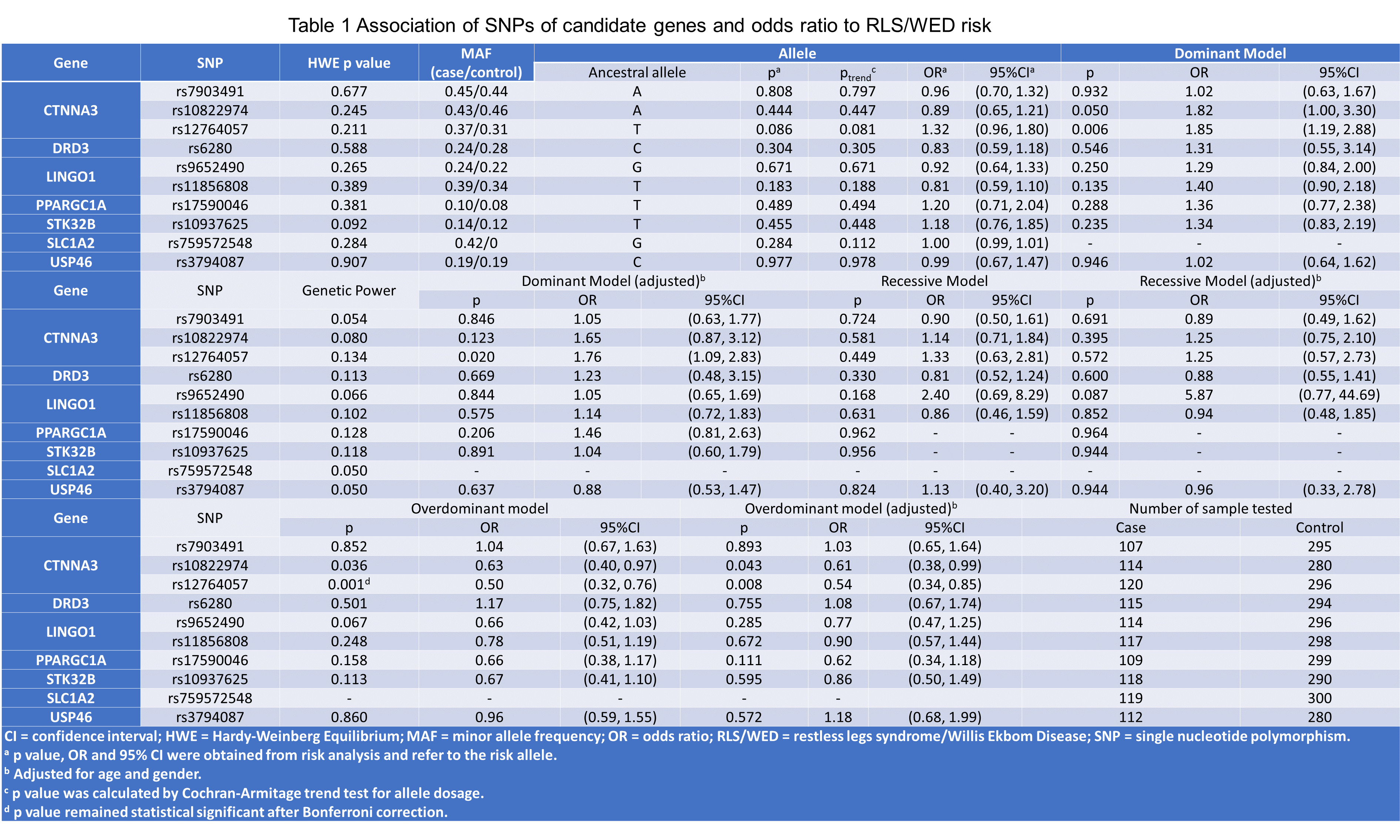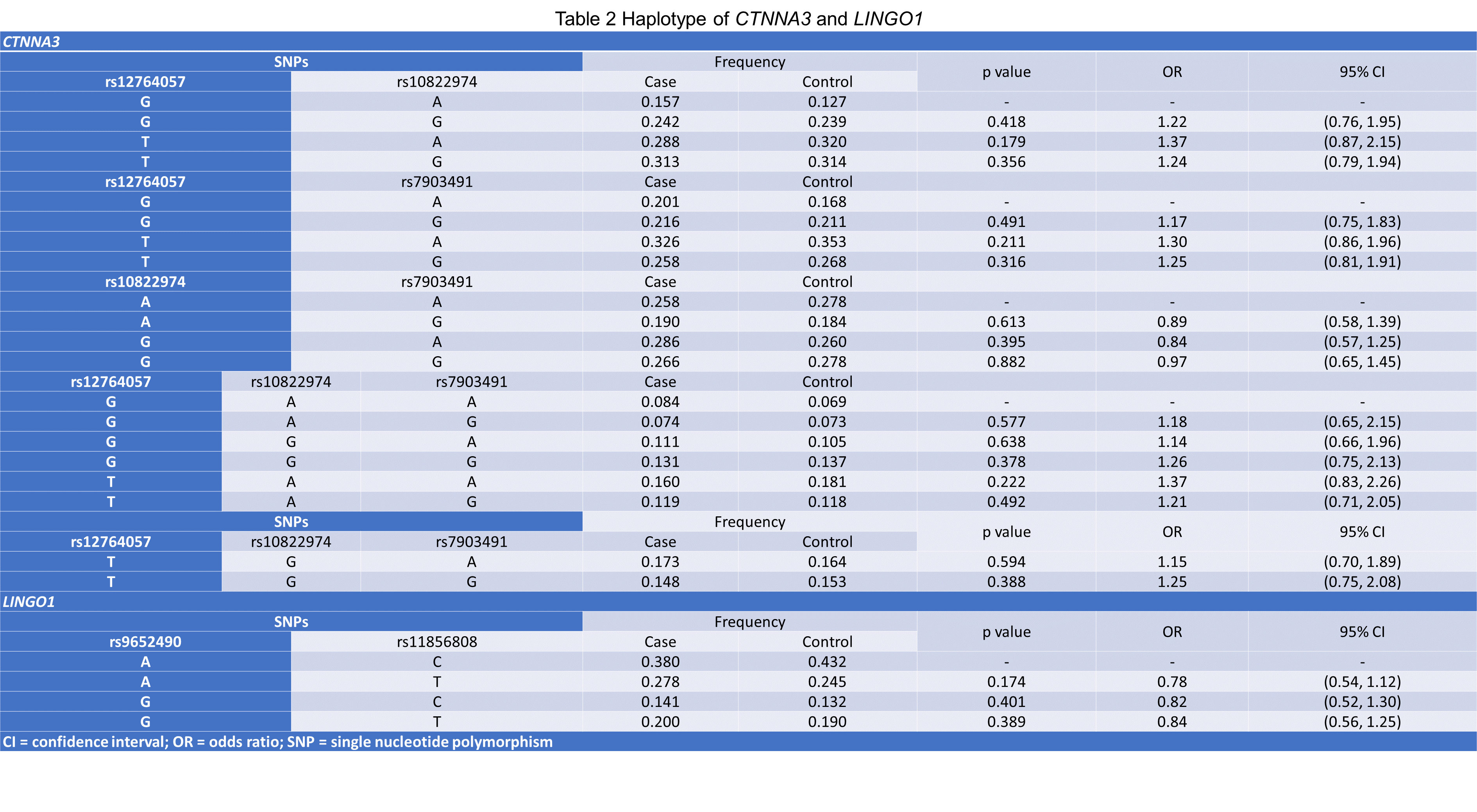Session Information
Date: Sunday, October 7, 2018
Session Title: Restless Legs Syndrome and Other Sleep Disorders
Session Time: 1:45pm-3:15pm
Location: Hall 3FG
Objective: The aim of this study was to investigate the relationship between genetic markers of essential tremor and primary restless legs syndrome/Willis-Ekbom Disease (RLS/WED) in southern Chinese population.
Background: Restless legs syndrome/Willis-Ekbom disease (RLS/WED) is a sleep disorder characterized by an irresistible urge to move legs, sometimes accompanied by various sensory complaints, which worsens at night and alleviated by walking, affecting their quality of daily lives. Movement disorders, such as Parkinson’s disease and essential tremor, are not uncommonly co-occurred in RLS/WED patients. Interestingly, both diseases are inheritable and sometimes co-segregated in the same family, suggesting a possibility of common genetic mechanism. So far, single nucleotide polymorphisms (SNPs) associated with the risk of essential tremor included CTNNA3, LINGO1, SLC1A2, FUS, SCN4A, DRD3, HTRA2, HAPLN4, HS1BP3, USP46, STK32B, TENM4, KCNS2, NOS3 and PPARGC1A. It is unknown whether these risk SNPs of essential tremor are also associated with RLS/WED. In this study, we sequenced those genetic markers in Chinese RLS patients, to investigate the genetic link between RLS/WED and ET in Chinese population.
Methods: Totally, 121 RLS/WED patients and 300 healthy controls were enrolled based on the diagnostic criteria of International RLS Study Group in 2014. MassARRAY and polymer chain reaction (PCR) and sequencing were used to detect 16 single nucleotide polymorphisms (SNPs) and 16 mutations of 15 genes. MassARRAY system was used to genotype these SNPs and mutations: rs571210585 of SCN4A, rs781390304 of HAPLN4, rs759572548 of USP46, rs72470545 of HTRA2, rs11680700 of HS1BP3, rs6280 of DRD3, rs9652490 and rs11856808 of LINGO1, rs3794087 of SLC1A2, rs387907274 and rs751937417 of FUS; KCNS2 c.1137T>A, NOS3 c.46G > A, NOS3 c.164C > T, FUS c.1129C > T, TENM4 c.158G>C, TENM4 c.1421C>A, TENM4 c.1553G>A, TENM4 c.3053G>A, TENM4 c.3382G>A, TENM4 c.3412G>A, TENM4 c.4100C>A, TENM4 c.4324G>A, TENM4 c.4603A>C, TENM4 c.4895G>A, TENM4 c.5287G>A and TENM4 c.7353G>A.
Results: Our study found that only overdominant model of rs12764057 of CTNNA3 remained statistical significant before adjusting age and gender (odds ratio [OR] = 0.50, p=0.001). rs10822974 of CTNNA3 and rs9652490 of LINGO1 had the trend to be associated with RLS/WED.
Conclusions: Our results suggested the association of rs12764057 of CTNNA3, a novel gene related with essential tremor, with primary RLS/WED in southern Chinese population. Besides, rs10822974 of CTNNA3 and rs9652490 of LINGO1 had the trend to be associated with RLS/WED.
To cite this abstract in AMA style:
G. Li, HD. Tang, P. Huang, YC. He, C. Wang, XM. Qi, J. Chen, JF. Ma, SD. Chen. Genetic Markers of Essential Tremor in Restless Legs Syndrome/Willis-Ekbom Disease in Southern Chinese Population [abstract]. Mov Disord. 2018; 33 (suppl 2). https://www.mdsabstracts.org/abstract/genetic-markers-of-essential-tremor-in-restless-legs-syndrome-willis-ekbom-disease-in-southern-chinese-population/. Accessed December 17, 2025.« Back to 2018 International Congress
MDS Abstracts - https://www.mdsabstracts.org/abstract/genetic-markers-of-essential-tremor-in-restless-legs-syndrome-willis-ekbom-disease-in-southern-chinese-population/


